Magnolia trees have been around for centuries and are famous for their enchanting blossoms. They come from a timeless ancestry that has beautified the world for generations.
In this article, you’ll discover everything you need to know about magnolia tree types, ranging from magnificent tall trees to petite shrubs.
Key Takeaways
- Magnolias span a range from towering trees to small shrubs.
- The Southern magnolia is a large evergreen species, symbolic of the South.
- Saucer magnolia and Star magnolia are among the most popular varieties for gardens.
- Magnolia care varies by type, but with attention to detail, these trees and shrubs can thrive in a variety of environments.
The world of magnolia trees is vast, and it’s easy to be overwhelmed when learning about caring for these gorgeous trees. That’s why I put together the Ultimate Guide to Magnolia Trees with everything you need to know all in one place. Check it out today!
Types of Magnolias
Magnolia is one of the most versatile plants. Its range includes evergreen and deciduous varieties, multi-stemmed shrubs, stately upright trees, and compact dwarf trees.
The magnolia tree care differs slightly for each type, but their allure remains consistent.
1. Southern Magnolia (Magnolia grandiflora)

The classic Southern magnolia is a large evergreen tree renowned for its large, glossy green leaves and fragrant white flowers.
The magnolia flowers appear predominantly in late spring with sporadic blooming in summer. Its seed pods are deep brown and offer another visual element in the landscape.
- Best for Grow Zones: 7-10
- Flower Color: White
- Mature Size: 60-80 feet
- Light Requirement: Full sun to partial shade
2. Little Gem Magnolia (Magnolia grandiflora ‘Little Gem’)
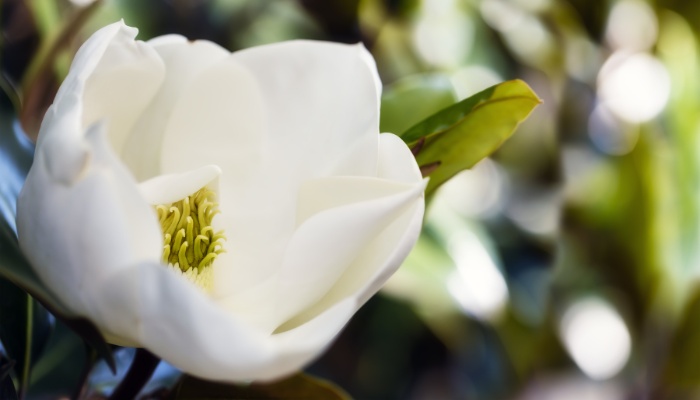
The Little Gem variety is essentially a compact version of the Southern magnolia.
A small tree, it boasts similar glossy leaves and white flowers but grows to a much more manageable height, making it ideal for smaller gardens.
- Best for Grow Zones: 7-9
- Flower Color: White
- Mature Size: 20-25 feet
- Light Requirement: Full sun
3. Sweetbay Magnolia (Magnolia virginiana)
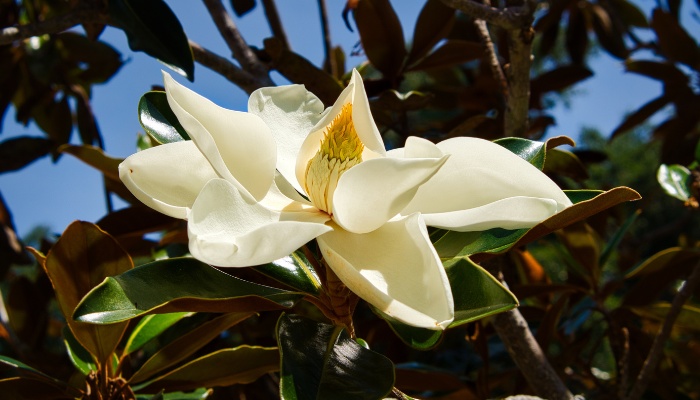
Often referred to as the swamp magnolia, Sweetbay Magnolia is a deciduous or semi-evergreen tree. Its creamy-white flowers offer a lemony fragrance, primarily blooming in late spring and early summer.
- Best for Grow Zones: 5-9
- Flower Color: Creamy-white
- Mature Size: 10-35 feet
- Light Requirement: Full sun to partial shade
4. Fairy Magnolia (Magnolia ‘Fairy’)

The Fairy magnolia is known for its profusion of fragrant blooms that grace the shrub early in spring.
Typically, this magnolia variety produces blush-pink flowers, but some cultivars might lean toward a creamy-white hue.
It’s a deciduous shrub or small tree, making it perfect for tighter spaces where a full-sized magnolia tree might be overwhelming.
- Best for Grow Zones: 6-9
- Flower Color: Pink to creamy-white
- Mature Size: 10-15 feet
- Light Requirement: Full sun to partial shade
5. Kay Parris Magnolia (Magnolia grandiflora ‘Kay Parris’)
A cultivar of the Southern magnolia tree, the Kay Parris magnolia has a compact habit with the same classic magnolia look.
It blooms in early summer, with the flowers appearing significantly earlier than the traditional Southern magnolia.
Its wavy, green leaves and highly fragrant white flowers make it a favorite magnolia among many.
- Best for Grow Zones: 7-9
- Flower Color: White
- Mature Size: 20-25 feet
- Light Requirement: Full sun to partial shade
6. Teddy Bear Magnolia (Magnolia grandiflora ‘Teddy Bear’)
The Teddy Bear magnolia grows as a compact, evergreen tree, but its real charm lies in its dense, oval-shaped canopy and beautiful, fragrant, white flowers.
This magnolia tree type offers large leaves, reminiscent of the Southern magnolia with a rust-colored underside.
- Best for Grow Zones: 7-9
- Flower Color: White
- Mature Size: 16-20 feet
- Light Requirement: Full sun to partial shade
7. Bubbles Magnolia (Magnolia ‘Bubbles’)
This magnolia species stands out with its impressive display of white to pink flowers in the spring.
Often grown as a shrub or small tree, Bubbles magnolia blooms later, which means those flowers stand a better chance against late frost.
- Best for Grow Zones: 5-9
- Flower Color: White to Pink
- Mature Size: 8-12 feet
- Light Requirement: Full sun
8. Scented Pearl Magnolia (Magnolia laevifolia ‘Scented Pearl’)

This magnolia variety presents with exquisite white flowers that have a touch of pink at their base.
Its blooms are highly fragrant, and it often grows as a small tree or large shrub.
- Best for Grow Zones: 6-9
- Flower Color: White with hints of pink
- Mature Size: 12-15 feet
- Light Requirement: Full sun to partial shade
9. Port Wine Magnolia (Magnolia figo ‘Port Wine’)

This evergreen magnolia is a variety of the Figo magnolia and is a favorite for many gardeners. Its light-purple-maroon flowers make a striking contrast with its glossy green leaves.
- Best for Grow Zones: 7-10
- Flower Color: Purple-maroon
- Mature Size: 6-10 feet
- Light Requirement: Full sun to partial shade
10. White Caviar Magnolia (Magnolia figo x yunnanensis ‘White Caviar’)
Originating from the Figo magnolia, this deciduous tree offers large, tulip-shaped, fragrant, white flowers in early spring.
A common magnolia in many eastern gardens, it is appreciated for its elegant appearance and rapid growth.
- Best for Grow Zones: 5-8
- Flower Color: White
- Mature Size: 15-20 feet
- Light Requirement: Full sun
11. Figo Magnolia (Magnolia figo)

A smaller evergreen magnolia, the Figo, or Banana Shrub as it’s commonly known due to its banana-scented flowers, is perfect for gardens with limited space.
Its cream to pale yellow flowers appear in late spring and are a treat for the senses.
- Best for Grow Zones: 7-10
- Flower Color: Cream to pale yellow
- Mature Size: 6-10 feet
- Light Requirement: Full sun to partial shade
12. Saucer Magnolia (Magnolia x soulangiana)
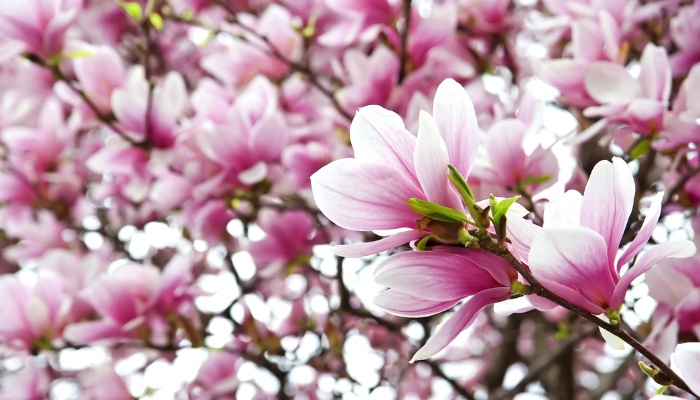
The saucer magnolia is one of the most popular types of magnolia trees and for a good reason. This deciduous tree boasts spectacular large flowers that range from white to pinkish-purple.
Blooming in early spring, these fragrant flowers often appear before the leaves unfurl, giving an impressive display against the bare branches.
- Best for Grow Zones: 4-9
- Flower Color: White to pinkish-purple
- Mature Size: 20-30 feet
- Light Requirement: Full sun to partial shade
13. Jane Magnolia (Magnolia x ‘Jane’)

A member of the “Little Girl” series, the Jane magnolia is a shrub or small tree that showcases stunning tulip-shaped, purple-red flowers with white interiors.
Flowering in late spring, the Jane magnolia blooms are less prone to damage from late frosts.
- Best for Grow Zones: 4-8
- Flower Color: Purple-red with white inside
- Mature Size: 10-15 feet
- Light Requirement: Full sun to partial shade
14. Ann Magnolia (Magnolia x ‘Ann’)

Similar to its sibling the Jane magnolia, the Ann magnolia is part of the “Little Girl” series.
This small tree or large shrub displays lovely purplish-red flowers in spring and occasionally in summer. It’s one of the best magnolia varieties for a vibrant late-season bloom.
- Best for Grow Zones: 4-8
- Flower Color: Purplish-red
- Mature Size: 8-10 feet
- Light Requirement: Full sun to partial shade
15. Betty Magnolia (Magnolia liliiflora x stellata ‘Betty’)

Another gem from the “Little Girl” series, the Betty magnolia delights gardeners with its purplish-red blooms with white interiors, emerging slightly later in spring, safeguarding them from potential late frosts.
- Best for Grow Zones: 4-8
- Flower Color: Purplish-red with white inside
- Mature Size: 10-15 feet
- Light Requirement: Full sun to partial shade
16. Star Magnolia (Magnolia stellata)

The Star magnolia is aptly named for its striking star-shaped flowers that radiate beauty.
A small tree or shrub, it comes alive with a multitude of fragrant, white flowers in early spring, making it a garden standout.
- Best for Grow Zones: 4-8
- Flower Color: White
- Mature Size: 15-20 feet
- Light Requirement: Full sun to partial shade
17. Big Leaf Magnolia (Magnolia macrophylla)
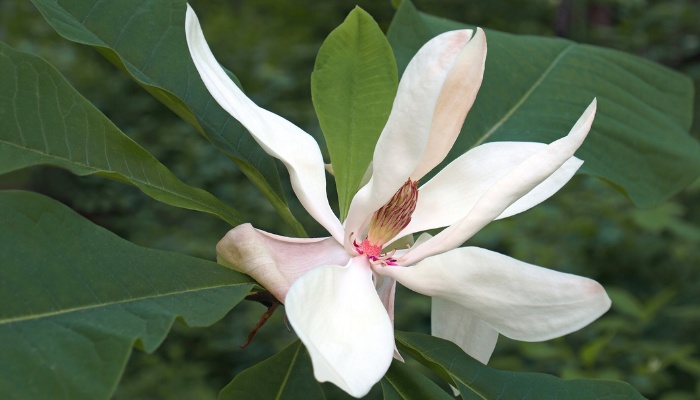
True to its name, the Bigleaf magnolia boasts the largest leaves and flowers of all magnolia species.
This deciduous tree produces immense, aromatic, creamy-white flowers in late spring. The huge leaves can grow up to 3 feet long, making it a unique landscape specimen.
- Best for Grow Zones: 5-8
- Flower Color: Creamy-white
- Mature Size: 20-40 feet
- Light Requirement: Full sun to partial shade
18. Cucumber Tree Magnolia (Magnolia acuminata)

Known as the cucumber tree due to its cucumber-like fruit, this magnolia variety is a deciduous tree native to eastern North America.
Its yellow-green flowers appear in late spring, followed by the distinctive cucumber-like fruit.
- Best for Grow Zones: 4-8
- Flower Color: Yellow-green
- Mature Size: 40-70 feet
- Light Requirement: Full sun to partial shade
19. Lily Magnolia (Magnolia liliiflora)
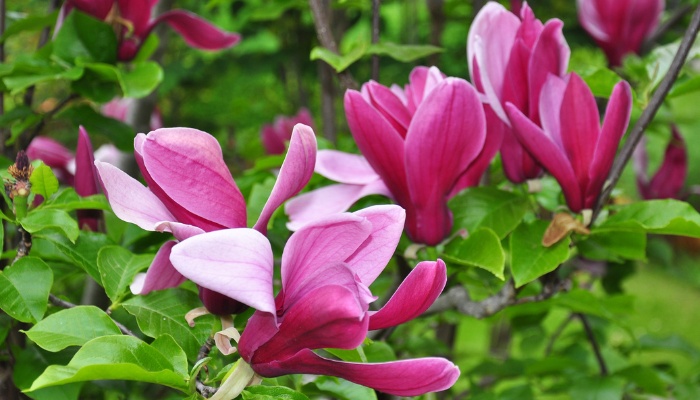
The Lily magnolia is a shrub or small tree that originates from southwest China. It’s particularly cherished for its goblet-shaped, purplish-pink flowers that bloom in spring.
This deciduous tree creates a delightful contrast when its dark-colored flowers are set against a background of green foliage.
- Best for Grow Zones: 6-9
- Flower Color: Purplish-pink
- Mature Size: 8-12 feet
- Light Requirement: Full sun to partial shade
20. Butterflies Magnolia (Magnolia acuminata ‘Butterflies’)

A stunning deciduous tree, the Butterflies magnolia is named for its vibrant, butterfly-like, yellow blooms.
These appear in early spring, creating a captivating spectacle. This magnolia variety is relatively cold-hardy and flowers at a young age.
- Best for Grow Zones: 5-9
- Flower Color: Yellow
- Mature Size: 15-20 feet
- Light Requirement: Full sun
21. Ashe Magnolia (Magnolia ashei)
Ashe’s magnolia, predominantly found in Florida, is admired for its massive leaves and large, fragrant, cup-shaped white flowers.
This small tree or large shrub is deciduous and has a naturally open and irregular growth pattern.
- Best for Grow Zones: 6-9
- Flower Color: White
- Mature Size: 10-20 feet
- Light Requirement: Full sun to partial shade
22. Yulan Magnolia (Magnolia denudata)

A classic magnolia species, the Yulan magnolia or lily tree is renowned for its elegant, large, fragrant, white flowers that bloom in early spring.
Native to central and eastern China, this deciduous tree has been cultivated for over a thousand years.
- Best for Grow Zones: 6-8
- Flower Color: White
- Mature Size: 30-40 feet
- Light Requirement: Full sun to partial shade
23. Kobus Magnolia (Magnolia kobus)

The Kobus magnolia is a deciduous tree from Japan. Blooming in early spring, it features dainty, star-shaped, white flowers.
The tree is also quite cold-hardy, making it suitable for northern gardens.
- Best for Grow Zones: 5-8
- Flower Color: White
- Mature Size: 25-30 feet
- Light Requirement: Full sun to partial shade
24. Loebner Magnolia (Magnolia × loebneri)
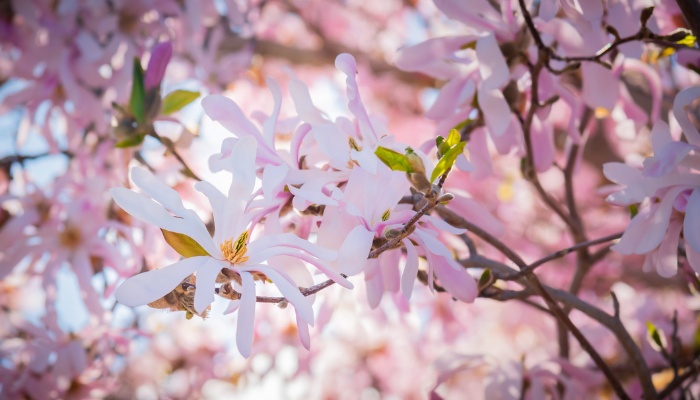
The result of crossing the Lily magnolia and the Kobus magnolia, the Loebner magnolia blooms in early spring, producing star-shaped flowers in shades of white and pink.
This deciduous tree is a favorite magnolia variety for many gardeners due to its hardiness and aesthetic appeal.
- Best for Grow Zones: 5-8
- Flower Color: White to pink
- Mature Size: 20-30 feet
- Light Requirement: Full sun to partial shade
25. Sprenger’s Magnolia (Magnolia x sprengeri)
A striking deciduous tree, Sprenger’s magnolia exhibits a rich array of white to pink flowers in early spring, preceding its leaves.
The petals of its blossoms, elongated and graceful, give the tree a classic magnolia look.
- Best for Grow Zones: 6-8
- Flower Color: Pink
- Mature Size: 20-25 feet
- Light Requirement: Full sun to partial shade
26. Sargent’s Magnolia (Magnolia sargentiana)

Native to western China, Sargent’s magnolia is a large tree known for its extensive, rosy-purple flowers.
Blooming in spring, its flower petals create a pleasant contrast with the tree’s dark green leaves.
- Best for Grow Zones: 6-8
- Flower Color: Rosy-purple
- Mature Size: 40-50 feet
- Light Requirement: Full sun to partial shade
27. Anise Magnolia (Magnolia salicifolia)

Also called the Willow-Leaved magnolia, this is a deciduous variety native to Japan.
The Anise magnolia blooms in early spring, presenting a show of white flowers with a gentle fragrance reminiscent of anise.
- Best for Grow Zones: 5-8
- Flower Color: White
- Mature Size: 20-30 feet
- Light Requirement: Full sun
28. Umbrella Magnolia (Magnolia tripetala)

As the name suggests, the Umbrella magnolia exhibits large leaves that are often arranged in a whorl at the end of stem branches, giving an “umbrella” appearance.
This deciduous tree also produces creamy-white flowers in late spring.
- Best for Grow Zones: 5-8
- Flower Color: Creamy-white
- Mature Size: 15-30 feet
- Light Requirement: Partial shade
29. Fraser Magnolia (Magnolia fraseri)
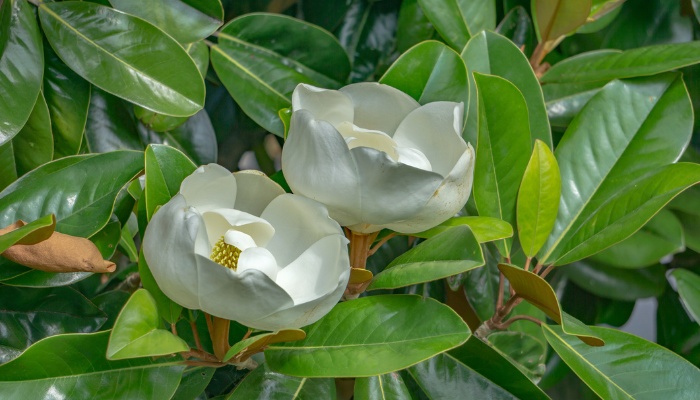
A sibling to the bigleaf magnolia, Fraser’s magnolia sports massive leaves and large white flowers. This tree grows best in woodlands and is native to the southeastern United States.
- Best for Grow Zones: 5-8
- Flower Color: White
- Mature Size: 20-40 feet
- Light Requirement: Partial shade
30. Yellow Bird Magnolia (Magnolia × brooklynensis ‘Yellow Bird’)
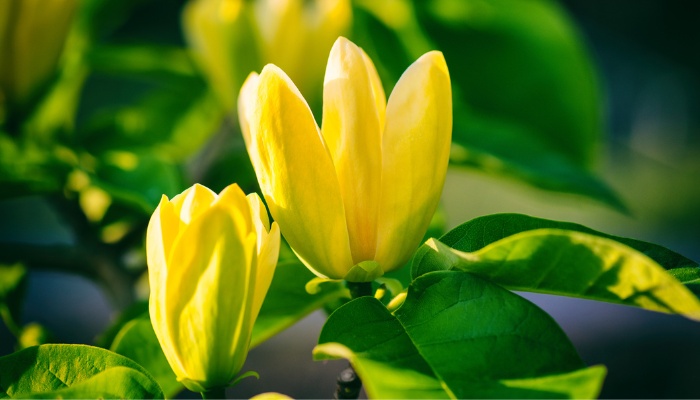
This tree is notable for its luminous yellow blooms that burst forth in spring.
The Yellow Bird magnolia is a hybrid variety, making it a standout in gardens with its unusual flower color among magnolia species.
- Best for Grow Zones: 4-8
- Flower Color: Yellow
- Mature Size: 30-35 feet
- Light Requirement: Full sun to partial shade
Closing Thoughts
Magnolias are truly enchanting trees and shrubs that enliven gardens and streetscapes worldwide.
Their diversity is their strength, from the classic Southern magnolia’s broad evergreen leaves and vast white flowers to the Star magnolia’s dainty star-shaped flowers.
No matter the size of your garden, there’s a magnolia species or hybrid that can bring elegance, color, and fragrance to your space.
